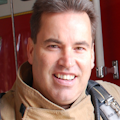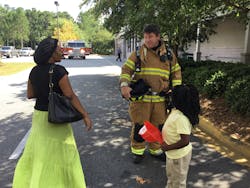Community Risk Reduction: Don’t Let the Steps of a CRR Program Intimidate You
There is the gold standard for community risk reduction (CRR). It’s complete with risk assessments, data analysis, stakeholders, evidence-gathering, problem statements, goal-forming, program assessments, and impact and outcome evaluations. Vision 20/20 has extensive information and resources for CRR, and the National Fire Academy (NFA) provides quality training, complete with fellow students who contribute a plethora of experiences to learn from. Like every gold standard, this should be what fire departments strive for, but for a young firefighter or newly promoted or hired CRR personnel, it certainly can be intimidating and daunting. It need not be. It’s as easy as 1, 2, 3.
Get into the community
I have spent almost my entire career conducting prevention and public education programs. Although I have been blessed with supportive fire chiefs, I have been in a continual one-person fighting hole—it’s only me, resources are limited and CRR is just one of my numerous duties. Add the fact that I am in a jurisdiction where other agencies don’t understand—thus, don’t prioritize—CRR, and that gold standard has been merely a goal to strive for but never to be fully realized. In the meantime, citizens lost homes and were injured or worse, and my fellow firefighters were put at risk in very predictable, thus preventable, events.
Throwing up my hands and using the lack of time and resources as an excuse weren’t options for me, nor should it be for you. So, when I write these columns, I keep in mind my fellow understaffed and overstretched CRR-orientated firefighters and departments who never can fully implement a CRR program but want to do something.
It’s this easy: 1) get out of your fire station and into the community; 2) start having conversations; and 3) do something.
Whether via an invitation to speak at an event or simply to be a guest or out at lunch or at home with neighbors, developing rapport and having conversations are the skeleton of CRR. If just one person with whom you speak goes home and installs a smoke alarm, purchases a fire extinguisher, wears a bicycle helmet or seat belt or finally accepts the fact that handrails at home are needed, risks are reduced and, very possibly, a home or life is saved.
Unintended but impactful
The following is an unintended but successful CRR program, which began by 1) being out of the fire station, 2) having a simple conversation and 3) doing something. (Names have been changed.)
While out in the community on administrative duties, a conversation was had with an older woman who was active within the local senior community (community leader) about the importance of blood-pressure monitoring. This conversation resulted in an invitation to one of her groups for blood-pressures checks. From that single conversation and invitation, word spread, which resulted in additional invitations to other senior groups (the at-risk) in the community, and, unknowingly, a successful CRR program was built.
The unplanned CRR impacts included:
Mrs. Smith was in her 70s. She might have weighed 100 lbs. soaking wet with a backpack on. Every month, firefighters went to her center for blood-pressure checks. Over time, through conversations and rapport, all of the ladies (coincidently, no men) got to know the “boys,” and trust was built. Over a year and a half, Mrs. Smith’s blood pressure was normotensive, until one day her blood pressure was well within the hypertensive crisis range, with a systolic of more than 290. After some questioning—and because of the trust and rapport that was established—she admitted that her doctor changed her medication. She got confused, didn’t like it and simply stopped taking it. After all, she “felt fine.” Luckily, because of the trust that was built, she allowed a firefighter to call her son, who then picked her up and took her to the doctor. The next month, Mrs. Smith had a better understanding of her medication and was back to normotensive.
Then there was Mrs. Jones. She was an independent, confident older adult who knew her health and what was best for her. Despite the firefighters being there every month, she refused to have her blood pressure checked. Again, after all, she felt fine.
One day, after some peer pressure from her friends and a little fun encouragement from the firefighters, she consented. Although her blood pressure was within the normal range, the firefighter immediately detected a highly irregular pulse. Because of the trust that was established, when asked whether she ever was diagnosed with a heart arrythmia, this prideful woman of meager means stated that she didn’t go to the doctor, because she feels fine. With the firefighter’s genuine expression of concern as well as encouragement from her companions, she consented and made an appointment. A week later, Mrs. Jones showed up at the fire station to thank the fire chief, stating, “Those firefighters saved my life.” She told the chief that she was now under doctor’s care for what she described as a “serious” heart condition.
Another unplanned CRR impact: After blood-pressure checks and a brief orientation to their new automated external defibrillator, firefighters visited a center to educate an older audience regarding the signs and symptoms of a heart attack and the fact that a leading killer in such situations was denial/people waiting too long to seek medical attention. Just a week later, that fire department responded to the very same center for a cardiac event. Upon questioning, an older adult patient told the paramedic, “Well, those firefighters said that if something doesn’t feel right, that I should call 9-1-1,” which he did with the encouragement of that same older, now educated, adult audience. Although he obviously was in cardiac distress, his eventual diagnosis is unknown, but transport certainly was warranted, according to the medic.
Local response knowledge
Do these exhibit a true CRR program? Let’s backtrack.
The risk of not monitoring blood pressure, and not knowing who the “at risk” audience was, was known simply through local response knowledge from the crews. A problem statement was unofficially formed: “A lack of awareness and education on cardiac health in older adults is leading to preventable cardiac issues that are resulting in illness, lengthy hospital stays and death.” A stakeholder was met, a conversation occurred, partnerships were formed and a program was born.
Over time, without being aware, impact and outcome analyses were made. They showed that consistently doing blood-pressure checks was leading to a reduction in serious cardiac events. These steps weren’t performed formally nor labeled as outlined in a CRR program, but yet by members 1) being out in the community, 2) having conversations and 3) taking action based on a nonanalytically determined problem, the steps were stumbled upon and pieced together. Although maybe rough around the edges, a successful CRR program was born, and lives were impacted and saved.
Small bites
I still am in a one-person fighting hole with numerous duties, but with a supportive fire chief, I am able to implement as much of a formal CRR program that time and resources allow. Often, I feel overwhelmed and that all of the bites that I have taken from this large CRR elephant seem to have consumed barely a toe. However, I try to keep a few things in mind.
First, those who are in my community are more likely to take advice from a trusted person than from a government employee who wears a badge. By simply getting out every day to meet and talk to my citizens, to develop rapport and to keep my finger on the community’s pulse, a difference can be made.
Second, although I might never know for sure, I trust that someone with whom I speak could be the person whose home, family or life is saved—or that the life of a fellow firefighter was saved because that member’s life wasn’t put at risk because a response to an emergency didn’t occur because I talked with that citizen.
When all else fails to generate the motivation that’s needed to take one more bite from that large elephant, there is a third thing to keep in mind—that something is better than nothing, and even just taking one more bite out of that CRR elephant reduces a community risk and makes a community better. At the very least, for those who follow behind me in CRR, there will be less of an elephant to consume.
So, pass the hot sauce, please.
About the Author

Daniel Byrne
DANIEL BYRNE is a community support officer for the Burton Fire District, Beaufort County, SC, and a retired assistant fire chief of training for the Georgia Air National Guard 165th Fire Department. A third-generation firefighter, he holds an associate degree and a bachelor’s degree in fire science as well as a master’s degree in public administration and disaster management. Byrne is an alumnus of the National Fire Academy. He received state and local awards for public relations and educational programs as well as community partnerships and served as a conference presenter and keynote speaker.
